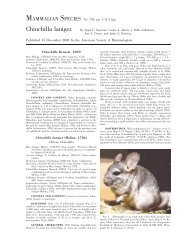Brugia Malayi - Clark Science Center - Smith College
Brugia Malayi - Clark Science Center - Smith College
Brugia Malayi - Clark Science Center - Smith College
Create successful ePaper yourself
Turn your PDF publications into a flip-book with our unique Google optimized e-Paper software.
Marine Mammal Health and Toxicology<br />
Victoria Dunch<br />
Coastal waters in the United States have become highly contaminated with pollutants as a result of industry, development and<br />
general non-point source pollution. The effects of these pollutants, which may bioaccumulate in the environment, are not well<br />
understood, but are believed to have a serious effect on marine mammal health. High concentrations of various pollutants such<br />
as Polychlorinated biphenyls (PCBs), Polybrominated diphenyl ethers (PBDEs), Perfluorocarbons (PFCs) and pesticides such as<br />
DDT have been found in blubber samples of Atlantic bottlenose dolphins (Tursiops truncatus). 1 PBDEs, for example, are used as<br />
flame retardants on a wide variety of products including building materials, electronics, furnishings, plastics and textiles. At high<br />
concentrations it is believed that these pollutants can compromise an animal’s immune system, which could contribute to mortality<br />
events either directly or indirectly from a compromised immune system allowing pathogens to invade. Bottlenose dolphins are apex<br />
predators, and thus accumulate high levels of pollutants from the environment. By studying the effects of toxins on these animals<br />
we may also grasp an understanding of their effects on us.<br />
Several projects have been undertaken to study the effects of chemical contaminants on these animals. One is the Bottlenose<br />
Dolphin Health and Risk Assessment (HERA) Project, which aims to assess the health of two populations of bottlenose dolphins<br />
in two estuarine areas on the United States’ eastern coast, Charleston, South Carolina (CHS) and the Indian River Lagoon, Florida<br />
(IRL). Over the course of two weeks beginning in June 2012, we received eleven skin samples obtained from dolphins captured<br />
and released in the IRL site. These samples were then incubated at 37° C and 5% CO₂ for twelve days in the hopes of growing<br />
fibroblast cells which we would then freeze down for cell storage and future testing. After about six days, the flasks of skin samples<br />
had to be observed daily for changes and fibroblast growth. Although unfortunately our samples became contaminated, most likely<br />
by a fungus, I learned sterile laboratory techniques and gained skills in cell culture methods.<br />
A tremendous amount of preparation is needed in order to conduct a dolphin health assessment study. I contributed to<br />
preparing the sample preparation kits for the collection of gastric, fecal, blowhole, urine, and blubber samples which will be used<br />
for the dolphin health assessment study in Charleston next summer. I was responsible for sterilizing necessary equipment, labeling<br />
and constructing the field kits and creating and inventory of all the various sample supplies such as veterinarian animal supplies,<br />
tubes, needles, syringes, and vials.<br />
A master’s thesis immune study to evaluate the effects of DE-71, a mixture of flame retardant chemicals, on macrophages<br />
was also in process. Spleens from B6C3F1 mice were minced and 1 million yeast cells were added to the macrophages to mimic an<br />
invasive body for them to engulf. DE-71 was then introduced at environmentally relevant concentrations from 0.0, to 0.05, 0.25,<br />
0.5, 2.5, 5.0, 25.0, and 50.0 µg/mL to determine if rates of phagocytosis differed. 2 This process was repeated on 30 slides which<br />
were then counted to determine the average engulfment rate for each concentration. I was involved in counting these slides on a<br />
Zeiss Axiovert S100 microscope to determine the percentage of phagocytosis.<br />
I was able to count roughly 30% of the slides this summer and the trends suggest that DE-71 may have a negative effect<br />
on macrophage phagocytosis. With the plethora of contaminants now found in marine environments, and with new chemicals<br />
being released every day, it is of increasing importance to better understand the effects of such pollutants on human and marine<br />
mammal health. (Supported by the Agnes Shedd Andreae 1932 Research Internship Fund)<br />
Advisors: Joanne Benkley and Patricia Fair, <strong>Center</strong> for Coastal Environmental Health &<br />
Bimolecular Research, National Oceanic and Atmospheric Administration (NOAA)<br />
References:<br />
1<br />
Fair, Patricia A. et al. 2010. Contaminant blubber burdens in Atlantic bottlenose dolphins (Tursiops truncatus) from two southeastern U.S.<br />
estuarine areas: Concentrations and patterns of PCB’s, Pesticides, PBDE’s, PFC’s and PAH’s. <strong>Science</strong> of the Total Environment, 408. 1577-1597.<br />
2<br />
Wirth, Jena R. Emerging Contaminants in the Marine Environment: Master Thesis. 2012.<br />
2012<br />
116

















